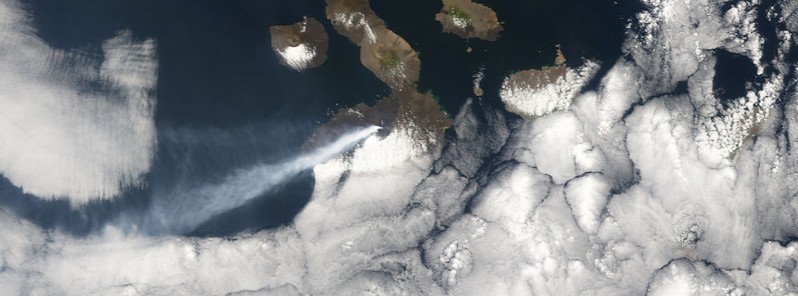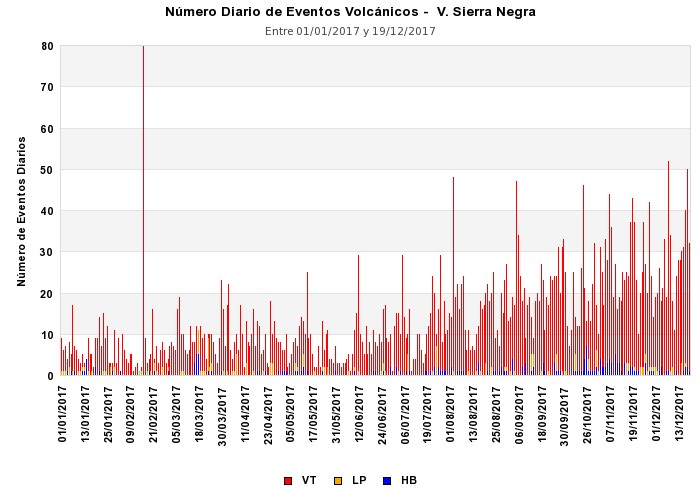Increased seismicity and rapid caldera inflation at Sierra Negra volcano, Galapagos

Increased seismicity and rapid caldera inflation are being observed at the Sierra Negra volcano on Isabela Island, Galapagos, IGEPN reports in a special bulletin released December 22, 2017. The last eruption of this volcano took place in 2005. The current inflation rate has reached a level higher than that shown before the 2005 eruption.
The Sierra Negra volcano is one of the most active volcanoes in Galapagos. Over the past 70 years, the volcano erupted 6 times, with the eruptions in 1979 and 2005 being the most recent. The eruptions in 2005, 1979, 1963 and 1953 were located in Chico volcano area and the NNE rim of the caldera. The lava flows generated in these eruptions have mainly been directed toward the N and NE flanks of Chico volcano, in some cases reaching Elizabeth Bay and in other cases filling the interior of the caldera.
The increase in seismic activity under the Sierra Negra volcano continues, IGEPN said, and the number of earthquakes now exceeds 50 per day. In addition, earthquakes with magnitudes up to ML3.3 have been registered in the vicinity of the caldera in recent days.
The activity is interpreted as related to the intrusion of magma inside the volcano, at relatively shallow depths (just a few km) under the caldera.

Sierra Negra volcano seismicity 2017. Credit: IGEPN
Since December 1, a total of 564 earthquakes have been detected, most of which have been considered as VT-type earthquakes (related to rock fracturing). Three of them had magnitudes between ML2.9 and 3.3 (December 15 – 18) and several of these earthquakes have been felt by the population in the upper zone of the volcano.
InSAR image studies conducted by the University of Miami (RSMAS) reveal rapid caldera inflation, with a rate of 70 cm (27.55 inches) this year. This is one of the highest reported inflations of active volcanoes worldwide, IGEPN said.
Since 2013, the Geophysical Institute of the National Polytechnic School (IGEPN) maintains a surveillance network of four broadband operating seismic stations for the Galapagos volcanoes, two of which (VCH1 and PVIL) are located in the vicinity of the Sierra Negra caldera.
Conclusions
Statistically, this volcano has an eruptive interval of 11.4 years, and the last eruptive event was in 2005, 12 years ago. The last historical eruptions have been located in the Chico volcano area and the NNE edge of the caldera and have not affected the population areas of Isabela.
The number of earthquakes shows a sustained increase in 2017, especially since July of this year. These were located in the vicinity of the caldera. The largest earthquake of this month had a magnitude of 3.3 (December 15) and was reported as felt by the population living near the volcano.
The observed caldera inflation shows a very high rate and has reached a level higher than that shown before the 2005 eruption.
Geological summary
The broad shield volcano of Sierra Negra at the southern end of Isabela Island contains a shallow 7 x 10.5 km (4.3 x 6.5 miles) caldera that is the largest in the Galápagos Islands. Flank vents abound, including cinder cones and spatter cones concentrated along an ENE-trending rift system and tuff cones along the coast and forming offshore islands.
The 1124-m-high (3 690 feet) volcano is elongated in a NE direction. Although it is the largest of the five major Isabela volcanoes, it has the flattest slopes, averaging less than 5 degrees and diminishing to 2 degrees near the coast. A sinuous 14-km-long (8.7 miles), N-S-trending ridge occupies the west part of the caldera floor, which lies only about 100 m (328 feet) below its rim. Volcán de Azufre, the largest fumarolic area in the Galápagos Islands, lies within a graben between this ridge and the west caldera wall.
Lava flows from a major eruption in 1979 extend all the way to the north coast from circumferential fissure vents on the upper northern flank. Sierra Negra, along with Cerro Azul and Volcán Wolf, is one of the most active of Isabela Island volcanoes. (GVP)
Featured image: Sierra Negra volcano erupting in 2005. Credit: NASA Terra/MODIS

Commenting rules and guidelines
We value the thoughts and opinions of our readers and welcome healthy discussions on our website. In order to maintain a respectful and positive community, we ask that all commenters follow these rules.